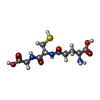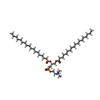+Search query
-Structure paper
| Title | Dead-end complex, lipid interactions and catalytic mechanism of microsomal glutathione transferase 1, an electron crystallography and mutagenesis investigation. |
|---|---|
| Journal, issue, pages | Sci Rep, Vol. 7, Issue 1, Page 7897, Year 2017 |
| Publish date | Aug 11, 2017 |
 Authors Authors | Qie Kuang / Pasi Purhonen / Johan Ålander / Richard Svensson / Veronika Hoogland / Jens Winerdal / Linda Spahiu / Astrid Ottosson-Wadlund / Caroline Jegerschöld / Ralf Morgenstern / Hans Hebert /  |
| PubMed Abstract | Microsomal glutathione transferase 1 (MGST1) is a detoxification enzyme belonging to the Membrane Associated Proteins in Eicosanoid and Glutathione Metabolism (MAPEG) superfamily. Here we have used ...Microsomal glutathione transferase 1 (MGST1) is a detoxification enzyme belonging to the Membrane Associated Proteins in Eicosanoid and Glutathione Metabolism (MAPEG) superfamily. Here we have used electron crystallography of two-dimensional crystals in order to determine an atomic model of rat MGST1 in a lipid environment. The model comprises 123 of the 155 amino acid residues, two structured phospholipid molecules, two aliphatic chains and one glutathione (GSH) molecule. The functional unit is a homotrimer centered on the crystallographic three-fold axes of the unit cell. The GSH substrate binds in an extended conformation at the interface between two subunits of the trimer supported by new in vitro mutagenesis data. Mutation of Arginine 130 to alanine resulted in complete loss of activity consistent with a role for Arginine 130 in stabilizing the strongly nucleophilic GSH thiolate required for catalysis. Based on the new model and an electron diffraction data set from crystals soaked with trinitrobenzene, that forms a dead-end Meisenheimer complex with GSH, a difference map was calculated. The map reveals side chain movements opening a cavity that defines the second substrate site. |
 External links External links |  Sci Rep / Sci Rep /  PubMed:28801553 / PubMed:28801553 /  PubMed Central PubMed Central |
| Methods | EM (electron crystallography) |
| Resolution | 3.5 Å |
| Structure data | |
| Chemicals |  ChemComp-GSH:  ChemComp-PC1:  ChemComp-PLM:  ChemComp-GTD: |
| Source |
|
 Keywords Keywords | TRANSFERASE / Membrane / Enzyme / Four-helical bundle / Trimer / Meisenheimer complex |
 Movie
Movie Controller
Controller Structure viewers
Structure viewers About Yorodumi Papers
About Yorodumi Papers








